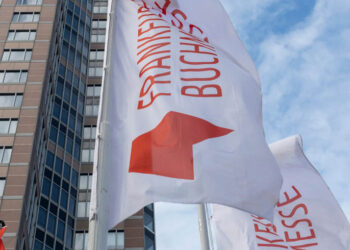
The story so far:
I have been working on a project on direct-to-consumer (D2C) marketing for university presses. I have been posting my findings and ruminations along the way; see, for example, here, here, and here . But as I have been reading through my notes I see that I may have fallen victim to a predilection of mine, and that is the syndrome known as “Go Big or Go Home”. I can’t help myself. When I was a little kid I would play poker with chips and loudly proclaim, “I raise you 10 million dollars!” My contestants would study their cards carefully, count their chips, and then fold their hands.
It is of course always easy to tell other people to Go Big. If you are playing with real money, though, and if your nonmonetary resources are limited–you may manage a small program or work for a university administration that does not put a high priority on its own publishing functions–you are always going to be told to Go Small or Be Extinguished. Indeed, how big can you play the game with revenue of $2 million dollars, a staff of a dozen people, and a subsidy of a few hundred thousand dollars? Organizations of this size and shape have limited options. It’s not that they should not Think Big–we should all be of the Think Big party–but it’s sometimes necessary to Think Big but Go Slowly, aka Go Big by Stealth. And here I must interject to say that I find it irksome when a librarian, sitting atop a cost center of over $30 million, contemptuously dismisses the activities of the affiliated university press as backward. It is much, much harder to run a profit center, even a subsidized one, of $2 million than a cost center of $50 million. Try it.
To Go Big for D2C marketing–to shoot the moon–really means to begin to recast a university press to be more like a professional society, where all the members and readers participate in research and teaching in the same intellectual space. Such a focus provides scale, which can be used for targeted marketing and new content development; it also could be leveraged into a conference business, which could be highly profitable. But a university press with $5 million in revenue and a list of 100 new titles each year, spread over 10 subjects, is far from a professional society; if it resembles anything, it looks like a corner grocery store or a tiny independent bookshop.
So what to do? To Go Big by Stealth our cunning university press may quietly begin to shift its editorial focus. It still publishes 100 books a year spread over 10 categories, but now the spread is uneven. One category is selected for intense focus (the amount of thinking that must go into choosing that single category is enormous), and the others are slightly scaled back. So now we have 9 categories with 8 titles per year, and one category with 28. That’s enough to begin a more targeted marketing effort. Over time 8 titles could become 7 and some categories could be dropped entirely. Our tiny, beleaguered press is beginning the shift to a direct-marketing company.
The next stealthy move is to rethink the Web site. While there are specific, practical aspects to this, the really important thing is conceptual: a press has to begin to think of itself as a Web publisher, not just a book publisher. All presses have Web sites; what’s at issue is the priority that is given to them and the need to hold someone accountable for the basic metrics: how many people come to the site each month, how many return, how long do they stick around, what do they do when they are there, etc. A press should look for these numbers to grow month by month. There is nothing radical about this; it is simply a matter of paying attention to the ecology of the Internet.
At this point a press is going to begin to do some hard thinking about its vendors. I have already written about the quest for the perfect vendor, but short of perfection, what are the options? Presses generally fall into 2 categories on this front, those that go it alone and those that become clients of larger organizations; there also are hybrid situations, which I will discuss in a minute. I am going to name names here, but before I do so, I want to be very clear that not listing an organization is not in any way an aspersion. The marketplace is chock full of excellent vendors and service providers. I welcome any vendor that does not get a mention here to raise a flag in the comments section. Presses should know what their options are.
In talking with presses about the vendors they work with, some names come up over and over. Do you need to manage your metadata carefully and generate ONIX feeds? Well, NetRead and Firebrand can help you with that. Firebrand is a key player in the university press world; many presses use Firebrand systems for the information management of their publishing programs and even to host Web sites. If a press wants to sell ebooks directly from its own Web site, it will also need a digital asset distributor to host files in different formats. Common choices are BiblioVault, a unit of The University of Chicago Press, and CoreSource, one of Ingram’s many services.
Presses may also need to do file conversions and choose to work with firms such as CodeMantra and Sheridan (there are many, many firms working in this area). Sheridan also builds Web sites for D2C marketing, an area in which it competes with such outfits as Impelsys. Impelsys also claims to provide search-engine optimization, a field with countless practitioners. If a press wants to make print editions available through print on demand, once again there are many options, with Ingram’s Lightning Source being the leader in this category.
There also are services that are just now coming into view that presses may want to consider. I am myself intrigued by the possibility of having branded ereading apps, which can be obtained from a Seattle-based company, BlueFire. Using BlueFire technology, a press can have its ebooks made viewable on any kind of mobile device, which is a lot better than trying to read a cramped PDF. For presses that are mining the marketing opportunities of social media, an arrangement with San Francisco’s Aerbook would give them the ability to embed marketing messages wherever users go: on Twitter, Facebook, Pinterest, etc.
There is, in other words, no shortage of vendors for presses that want to improve their D2C marketing. The problem is in knitting all these things together, a problem that looms larger the smaller the press. For this reason many presses seek to partner with larger entities, of which I will mention 4: CDC, a unit (like BiblioVault) of The University of Chicago Press; the services arm of Johns Hopkins University Press; Longleaf, a division of The University of North Carolina Press (I am an advisor to UNC Press); and Ingram, the largest of them all, especially now that Ingram has acquired the distribution business of Perseus.
Most of these organizations sell their services a la carte. For example, a press may work with BiblioVault but not with the fulfillment arm of CDC, or it may use Ingram’s Lightning Source for POD, but have logistics handled by Maple-Vail. There is a clear trend for these organizations to provide comprehensive services, bringing them closer to full solutions providers, a step toward becoming the perfect vendor. To become comprehensive most of these organizations adopt a hybrid model, choosing to package or “front-end” other services provided by third parties. Thus CDC has an arrangement for metadata management with Firebrand and Longleaf has just signed an agreement with Aerbook.
What this means as a practical matter is that the obstacles to effective D2C marketing are not technological or aspects of infrastructure; all these things can be purchased either one by one or as an almost comprehensive package from a bigger organization. The real issue is marketing. How do we call attention to our books? How can we make someone buy our books and not someone else’s? And how do we get them to buy them from us and not from a third party?
So once again we find ourselves returning to the problem of critical mass and getting people to come to a press’s own Web site. This is what underlies the recommendation to focus intensely on fewer and fewer subject areas, but it also naturally invites a press to think about forging partnerships with other presses. If my press has a catalogue of titles in computational biology, and another press is also developing a program in this area, what opportunity is there to market both programs together?
This was the motivation behind UPs in Space, an aggregation of books by various university presses on space studies. MIT Press took the lead in putting this together, and they are to be commended for it. But there is more that can be done here. For example, there is little in the way of content marketing on the site, which is necessary to drive Web traffic; and the fulfillment of the titles is uneven (some books have only print editions, some have ePubs, etc.) because the links go back to the Web sites of the individual presses. The site, in other words, is a confederation, not an integrated service. Let’s call this version 1.0 and look forward to subsequent iterations that reach out into the marketplace and drive greater and greater sales.
What the MIT project shows is that as presses attempt to develop closer relationships with end-users through D2C marketing, new strategies, new collaborations come into view. The evolving university press world will have more and more D2C activity, a narrower focus for each press, and a variety of means to develop critical mass for marketing. And all of these steps are available to every press now, regardless of their size. D2C is on its way to becoming a growing marketing channel for academic publishing. This is the tide of the Internet. Let’s swim.
Discussion
4 Thoughts on "Some Practical Steps toward D2C Marketing"
One aspect of university press publishing that does not exist for commercial academic publishers is that the former, but not the latter, is subsidized in various ways, which can affect how and whether vendors are chosen to perform various functions such as those Joe describes. To give an example concerning the press I headed at Penn State, several times we explored the possibility of outsourcing our order fulfillment and warehouse operations, but the fact that the warehouse was supplied by the university to the press at no cost hugely affected the cost calculations for the press in deciding whether or not to outsource. despite some real advantages the external vendor could offer, we could never manage to justify outsourcing in purely financial terms because we bore no cost for the warehouse itself. This is a peculiarity of university presses that may puzzle outside observers who don’t understand the internal subsidy arrangements. Joe understood our situation because he was a consultant to Penn State on one of the occasions this discussion took place.
If the “real issue is marketing,” and I agree, the press should look for more ways to exploit its intellectual partners — its authors. Even the most reclusive academic authors have correspondents, students, and other potential book buyers, but what do they do to help the press sell their books? How can the press encourage them?
Thanks for another mini Continuing Ed in Publishing course! It all makes sense as usual.



